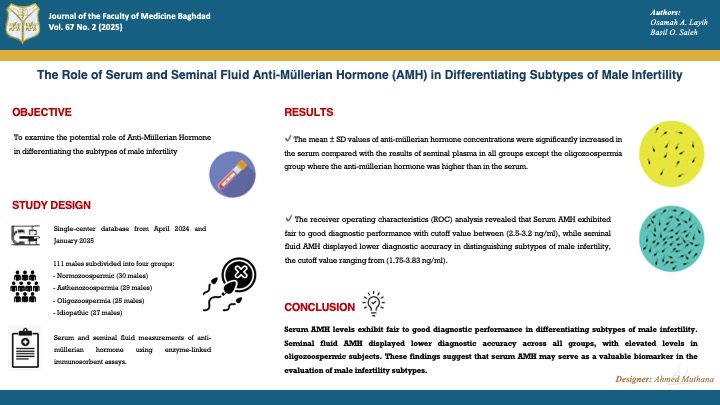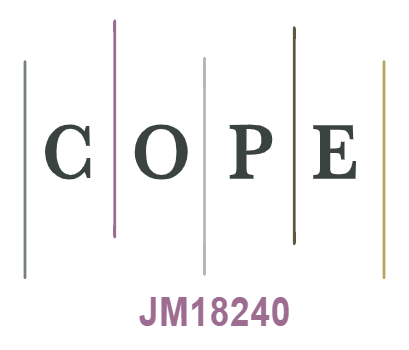دور الهرمون المضاد للمولر في مصل الدم والسائل المنوي في تمييز الأنماط الفرعية لعقم الذكور
DOI:
https://doi.org/10.32007/jfacmedbaghdad3131الكلمات المفتاحية:
الهرمون المضاد لمولر، وهن النطاف، قلة النطافالملخص
خلفية البحث: العقم هو عدم القدرة على الإنجاب بعد عام واحد من الجماع غير المحمي، حيث تعود 50% من الحالات إلى عوامل ذكورية. يُعدّ الهرمون المضاد للمولر ، وهو بروتين سكري ، أحد الإفرازات التي تطلقها خلايا سيرتولي، ويلعب دورًا رئيسيًا في التمايز الجنسي الذكري. كما يُستخدم كمؤشر حيوي لوظيفة خلايا سيرتولي والقدرة التناسلية للخصيتين.
الاهداف : تم تصميم هذه الدراسة لفحص الدور المحتمل للهرمون المضاد لمولر في التمييز بين الأنماط الفرعية للعقم الذكوري.
المرضى وطرق العمل/ المواد وطرق العمل: أُجريت دراسة الحَالات-الشواهد هذه في مركز العقم بمستشفى البتول التعليمي في محافظة ديالى، العراق، من قِبل قسم الكيمياء الحيوية / كلية الطب / جامعة بغداد، خلال الفترة من نيسان 2024 إلى كانون الثاني 2025. شملت الدراسة 111 رجلاً تتراوح أعمارهم بين 20-55 عامًا، حيث تم تقسيم المشاركين إلى أربع مجموعات وفقًا لتحليل السائل المنوي:
المجموعة الضابطة (النورموزوسبيرميا): 30 رجلًا يتمتعون بمستويات طبيعية من الحيوانات المنوية.
مجموعة الوهن النطفي (أستينوزوسبيرميا): 29 رجلًا يعانون من ضعف في حركة الحيوانات المنوية.
مجموعة قلة النطاف (أوليجوزوسبيرميا): 25 مريضًا يعانون من انخفاض عدد الحيوانات المنوية.
مجموعة العقم مجهول السبب: 27 رجلًا يعانون من العقم دون سبب واضح.
تم قياس مستويات الهرمون المضاد لمولر في كل من مصل الدم والسائل المنوي باستخدام تقنية المقايسة المناعية المرتبطة بالإنزيم.
النتائج: أظهرت النتائج أن المتوسط والانحراف المعياري لمستويات الهرمون المضاد للمولر كان أعلى بشكل ملحوظ في مصل الدم مقارنة بالسائل المنوي في جميع المجموعات، باستثناء مجموعة قلة النطاف، حيث كانت مستويات الهرمون في السائل المنوي أعلى من المصل. كما كشفت تحليلات منحنيات خصائص التشغيل للمستقبِل أن الهورمون المضاد للمولر في مصل الدم أظهر أداءً تشخيصيًا يتراوح بين جيد إلى متوسط، في حين أن نتائجه في السائل المنوي أظهرت دقة تشخيصية أقل في التمييز بين الأنماط الفرعية للعقم الذكوري.
الاستنتاجات: تشير النتائج إلى أن قياس الهورمون المضاد للمولر في مصل الدم قد يكون مؤشرًا بيولوجيًا ذا قيمة في تقييم الأنماط الفرعية للعقم الذكوري.
مفتاح الكلمات: الهرمون المضاد لمولر، وهن النطاف، قلة النطاف، بلازما السائل المنوي، العقم مجهول السبب.
المراجع
1. Ghewade P, Vagha S, Ghewade B, Gadkari P. Role of Dietary Antioxidant Supplements in Male Infertility: A Review. Cureus. 2024;16(6). https://doi.org/10.7759/cureus.61951
2. Agarwal A, Baskaran S, Parekh N, Cho CL, Henkel R, Vij S, et al. Male infertility. The Lancet. 2021;397(10271):319-33. https://doi.org/10.1016/S0140-6736(20)32667-2
3. Alani GT, El Yaseen HD. Creatine kinase activity and malondialdehyde in the seminal plasma of normospermic infertile males. Journal of the Faculty of Medicine Baghdad. 2009;51(3):336-40.
https://doi.org/10.32007/jfacmedbagdad.5131146
4. Aziz ASA, Elyaseen HD. Kadhem HK. Correlation between MDA Level and Chitotriosidase-1 Activity in Seminal Fluid of Iraqi Infertile Males. Journal of the Faculty of Medicine Baghdad. 2024;66(4):479-86. https://doi.org/10.32007/jfacmedbaghdad.6642395
5. Pereira R, Sousa M. Morphological and molecular bases of male infertility: a closer look at sperm flagellum. Genes. 2023;14(2):383. https://doi.org/10.3390/genes14020383
6. Salman FS, Al-Qadhi HI, Al Kareem BA. N-acetyl cysteine's effect on semen parameters in a sample of Iraqi men with oligoasthenoteratozoospermia. Journal of the Faculty of Medicine Baghdad. 2022;64(3):170-4. https://doi.org/10.32007/jfacmedbagdad.6431938
7. Xu H, Zhang M, Zhang H, Alpadi K, Wang L, Li R, et al. Clinical Applications of Serum Anti-Müllerian Hormone Measurements in Both Males and Females: An Update. Innovation. 2021;2(1):100091. https://doi.org/10.1016/j.xinn.2021.100091
8. Josso N, Picard JY. Genetics of anti-Müllerian hormone and its signaling pathway. Best Practice & Research Clinical Endocrinology & Metabolism. 2022;36(1):101634. https://doi.org/10.1016/j.beem.2022.101634
9. Howard JA, Hart KN, Thompson TB. Molecular mechanisms of AMH signaling. Frontiers in Endocrinology. 2022;13:927824. https://doi.org/10.3389/fendo.2022.927824
10. Olumide OB, Godwin AI, Titilayo JO, Christian IO, Etukudoh NS, Uchejeso OM, et al. Assessment of Serum Anti-Müllerian Hormone (AMH) as an Independent Marker for Oligozoospermia and Non-Obstructive Azoospermia in Infertile Nigerian Men. Biomedical and Pharmacology Journal. 2023;16(1):35-42. https://doi.org/10.13005/bpj/2585
11. Yuanyuan Z, Guicheng Z, Yi Z, Jiang X. From biological marker to clinical application: the role of anti-Müllerian hormone (AMH) for delayed puberty and idiopathic non-obstructive azoospermia in males. Endocrine connections. 2025; EC-24. https://doi.org/10.1530/EC-24-0630
12. Vannapraseuth B. WHO Laboratory Manual for the Examination of Human Semen and Sperm-cervical Mucus Interaction 4th Edition. The Australian Journal of Medical Science. 2005;26:100. https://api.semanticscholar.org/CorpusID:57556090
13. Poulet PE, Tran M, Tezenas du Montcel S, Dubois B, Durrleman S, Jedynak B. Prediction-powered inference for clinical trials. medRxiv. 2025;2001-25. https://doi.org/10.1101/2025.01.15.25320578
14. Ramlau-Hansen CH, Thulstrup AM, Aggerholm AS, Jensen MS, Toft G, Bonde JP. Is smoking a risk factor for decreased semen quality? A cross-sectional analysis. Human Reproduction. 2007;22(1):188-96. https://doi.org/10.1093/humrep/del364
15. Irteimah T, Al Dubais A, Al Rubaihat R. The Impact of Hookah on Anti-mullerian Hormone Level. Journal of the Royal Medical Services. 2022;29(1):28-35. https://doi.org/10.12816/0060310
16. Banihani SA, Shefa'M A. Men with oligozoospermia had lower level of seminal plasma pyridoxine compared to normozoospermic men. Heliyon. 2022;8(12). https://doi.org/10.1016/j.heliyon.2022.e11983
17. Melnyk O V, Vorobets MZ, Fafula R V, Onufrovych OK, Vorobets ZD. Features of spermogram indicators in idiophatic infertility in men. Bulletin of Problems in Biology and Medicine. 2022;167:187-92. https://doi.org/10.29254/2077-4214-2022-4-167-187-192
18. Ahmad SS, Al-Murshidi SY. Evaluation the level of antisperm antibodies, some cytokines and zinc for oligozoospermia, asthenozoospermia patients compared with normozoospermia. International journal of health sciences. 2022;6(S6):5324-31. https://doi.org/10.53730/ijhs.v6nS6.10907
19. Bonanno O, Romeo G, Asero P, Pezzino FM, Castiglione R, Burrello N, et al. Sperm of patients with severe asthenozoospermia show biochemical, molecular and genomic alterations. Reproduction. 2016;152(6):695-704. https://doi.org/10.1530/REP-16-0342
20. Al-Nedaw IA, Hassan SY. A Comparison of ICSI Outcomes and Reactive Oxygen Species Levels in Seminal Plasma between Normozoospermia and Sperm Abnormalities Groups for Infertile Men. Kufa Medical Journal. 2023;19(2). https://doi.org/10.36330/kmj.v19i2.12866
21. Jaber ZA, Mohammed AA, Rahim AI, Technologies AR. Correlation of serum and seminal plasma anti-mullerian hormone with fertility hormones profile and semen parameters. Obstetrics & Gynaecology Forum. 2024;(3):1491-7.
https://obstetricsandgynaecologyforum.com/index.php/ogf/article/view/516
22. Holt R, Yahyavi SK, Kooij I, Andreassen CH, Andersson AM, Juul A, et al. Low serum anti-Müllerian hormone is associated with semen quality in infertile men and not influenced by vitamin D supplementation. BMC Medicine. 2023;21(1):1-10. https://doi.org/10.1186/s12916-023-02782-1
23. Castellini C, Totaro M, Parisi A, D'Andrea S, Lucente L, Cordeschi G, et al. Bisphenol A and male fertility: Myths and realities. Frontiers in endocrinology. 2020;11:540459. https://doi.org/10.3389/fendo.2020.00353
24. Turhan G, Çil N, Kabukçu C, Turan T, Fenkçi İV, Abban MG. Relationship of seminal plasma anti-Müllerian hormone concentration with sperm morphology and sperm DNA damage. Journal of Urological Surgery. 2022; https://doi.org/10.4274/jus.galenos.2022.2021.0121
25. Xiao H, Ding YL, Yang P, Chen Q, Huang HL, Chen X, et al. Association between anti-Müllerian hormone concentrations and sperm retrieval outcomes in patients with idiopathic nonobstructive azoospermia: a systematic review and meta-analysis. Asian Journal of Andrology. 2024;26(5):522-7. https://doi.org/10.4103/aja202419
26. Kang-sheng LIU, Hui YAO, Xiao-dong MAO, Xiao-yong T, Ya-jun C. Application of Anti-Müllerian Hormone in Diagnosis of Male Infertility. Journal of International Translational Medicine. 2017;5(1):19-22.
https://doi.org/10.11910/2227-6394.2017.05.01.04
27. Andersen JM, Herning H, Witczak O, Haugen TB. Anti-Müllerian hormone in seminal plasma and serum: association with sperm count and sperm motility. Human Reproduction. 2016;31(8):1662-7. https://doi.org/10.1093/humrep/dew121
28. Benderradji H, Barbotin AL, Leroy-Billiard M, Prasivoravong J, Marcelli F, Decanter C, et al. Defining reference ranges for serum anti-Müllerian hormone on a large cohort of normozoospermic adult men highlights new potential physiological functions of AMH on FSH secretion and sperm motility. The Journal of clinical endocrinology & metabolism. 2022;107(7):1878-87.
https://doi.org/10.1210/clinem/dgac218
29. Sabir FNK. Association of Anti-Mullerian Hormone with some physiological and immunological parameters of infertile males. Cellular and Molecular Biology. 2022;68(9):171-8. https://doi.org/10.14715/cmb/2022.68.9.27
30. Buratini J, Dellaqua TT, Dal Canto M, La Marca A, Carone D, Mignini Renzini M, et al. The putative roles of FSH and AMH in the regulation of oocyte developmental competence: From fertility prognosis to mechanisms underlying age-related subfertility. Human Reproduction Update. 2022;28(2):232-54. https://doi.org/10.1093/humupd/dmab044

التنزيلات
منشور
إصدار
القسم
الفئات
الرخصة
الحقوق الفكرية (c) 2025 Osamah A. Layih , Basil O. Saleh

هذا العمل مرخص بموجب Creative Commons Attribution 4.0 International License.











 Creative Commons Attribution 4.0 International license..
Creative Commons Attribution 4.0 International license..


